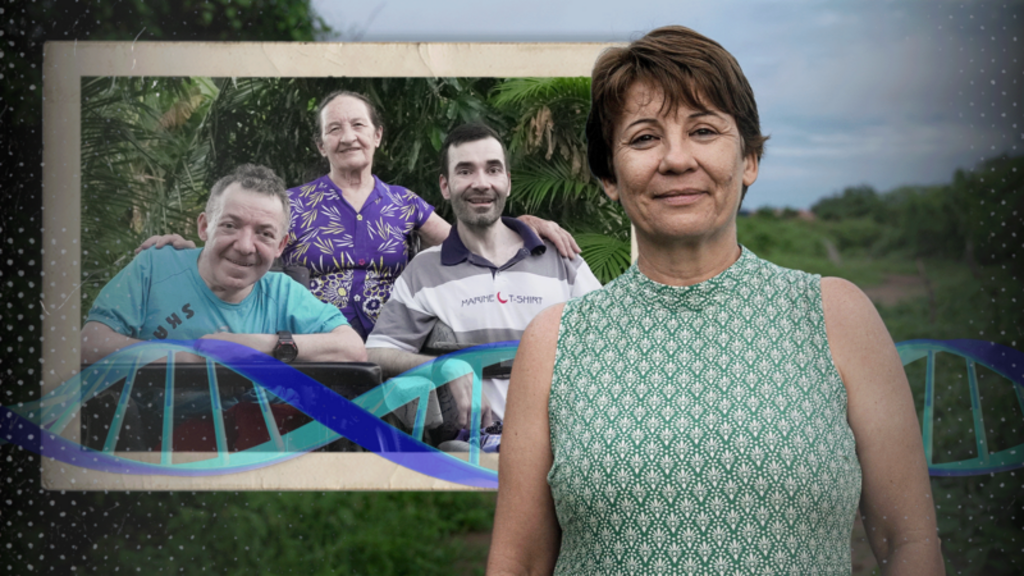Before Dr. Silvana Santos’s arrival in Serrinha dos Pintos over two decades ago, the unexplained paralysis affecting numerous children remained a mystery to the small northeastern Brazilian town’s residents.
In this community of fewer than 5,000, the biologist and geneticist identified and named a previously unknown genetic disorder: Spoan syndrome.
This syndrome, resulting from a genetic mutation affecting the nervous system, progressively weakens the body and manifests only when the altered gene is inherited from both parents.
Dr. Santos’s groundbreaking research, the first global description of the disease, earned her recognition as one of the BBC’s 100 most influential women in 2024.
Prior to her work, families lacked explanations; today, residents confidently discuss Spoan and its genetic basis.
“She gave us a diagnosis we never had. Following the research, help arrived: people, funding, wheelchairs,” says Marquinhos, one of the patients.
Dr. Santos’s São Paulo neighbors, many from the same extended family originating in Serrinha, initially alerted her to the prevalence of immobility in their hometown.
They recounted stories of numerous individuals unable to walk, a phenomenon they couldn’t explain.
One neighbor’s daughter, Zirlândia, exemplified the debilitating condition: involuntary eye movements in childhood progressed to limb weakness, ultimately requiring wheelchair assistance for even basic tasks.
Years of investigation by Dr. Santos and her research team culminated in the identification of these symptoms as Spoan syndrome, with 82 additional cases subsequently identified worldwide.
Invited by her neighbors, Dr. Santos’s initial holiday visit to Serrinha revealed a unique social dynamic amidst the stunning landscape.
She observed a surprisingly high frequency of cousin marriages, a consequence of the town’s geographical isolation and limited external migration, leading to a high degree of consanguinity.
While cousin marriage rates varied globally (over 50% in some regions, 1-4% in Brazil), this practice elevates the risk of transmitting harmful recessive genes.
“For unrelated couples, the risk of a child with a rare genetic disorder is 2–3%. For cousins, this rises to 5–6% per pregnancy,” explains geneticist Luzivan Costa Reis from Brazil’s Federal University of Rio Grande do Sul.
A 2010 study led by Dr. Santos revealed over 30% of Serrinha couples were related, with a third having at least one disabled child.
Driven to find a diagnosis, Dr. Santos initiated a comprehensive genetic study, requiring repeated trips and eventual relocation to the region.
Initially undertaking extensive travel between São Paulo and Serrinha, she collected DNA samples, engaging with residents, gathering family histories, and pursuing the genetic mutation responsible for the disease.
What began as a three-month project transformed into years of dedicated fieldwork.
This culminated in the 2005 publication revealing Spoan’s existence, identifying a chromosomal mutation leading to the overproduction of a key protein in brain cells.
“They said it came from Maximiano, a womaniser in our family,” recalls farmer Lolô, whose daughter Rejane has Spoan.
Lolô, now 83, a cousin-marrying lifelong Serrinha resident, continues to farm, relying on family to care for Rejane, who struggles with daily tasks.
However, the Spoan mutation predates the Maximiano legend; genetic evidence suggests a likely arrival over 500 years ago with early European settlers.
“Sequencing shows strong European ancestry in patients, aligning with records of Portuguese, Dutch, and Sephardic Jewish presence,” explains Dr. Santos.
This theory is reinforced by two Egyptian Spoan cases sharing European ancestry, pointing to a possible Iberian origin.
“It likely arrived with Sephardic Jews or Moors fleeing the Inquisition,” postulates Dr. Santos, anticipating more global cases, particularly in Portugal.
Despite limited treatment progress, patient tracking has brought positive change. The stigmatizing term “cripple” has been replaced by the clinical term “Spoan,” and wheelchairs provide independence and prevent deformities.
Spoan’s progression worsens with age; by 50, most patients require complete care, as evidenced by Inés’s sons Chiquinho (59, unable to speak) and Marquinhos (46, with limited communication).
“It’s hard having a ‘special’ child. We love them the same, but we suffer for them,” says Inés, married to a second cousin.
Larissa Queiroz (25), niece of Chiquinho and Marquinhos, also married a distant relative, discovering their shared ancestry after months of dating.
“In Serrinha dos Pintos, deep down, we’re all cousins,” she states.
Couples like Larissa and Saulo are the focus of a new Ministry of Health-backed research project, screening 5,000 couples for genes linked to serious recessive diseases.
The aim isn’t to discourage cousin marriage, but to inform couples of genetic risks, clarifies Dr. Santos, now a university professor leading a genetics education center and expanding testing in northeastern Brazil.
While no longer residing in Serrinha dos Pintos, each visit feels like a homecoming.
“It’s as if Santos is family,” says Inés.
Treating patients with a drug before surgery greatly reduced the chances of the cancer coming back, a small trial found.
NHS trusts “try to stop” coroners issuing Prevention of Future Death reports, an inquiry hears.
The Blues legend says he is enjoying the sun and playing golf after a year of illness.
Separate bills which would let terminally ill people end their life are being considered at Westminster and in Scotland.
Many are from the most deprived areas, and a significant number are neurodivergent or have other health conditions, a study says.

